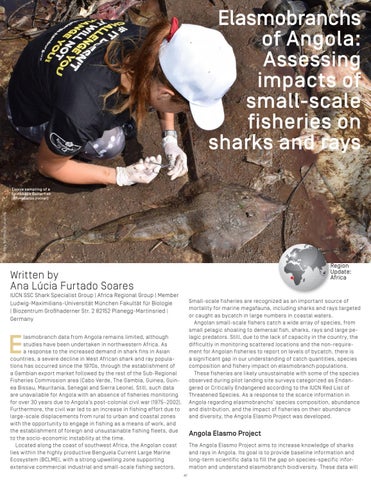Elasmobranchs of Angola: Assessing impacts of small-scale fisheries on sharks and rays
Photo by Antonio Mukanda
Tissue sampling of a Spineback Guitarfish (Rhinobatos irvinei)
Elasmobranchs of Angola: Assessing impacts of small-scale fisheries on sharks and rays Region Update: Africa
Written by Ana Lúcia Furtado Soares IUCN SSC Shark Specialist Group | Africa Regional Group | Member Ludwig-Maximilians-Universität München Fakultät für Biologie | Biozentrum Großhaderner Str. 2 82152 Planegg-Martinsried | Germany
Small-scale fisheries are recognized as an important source of mortality for marine megafauna, including sharks and rays targeted or caught as bycatch in large numbers in coastal waters. Angolan small-scale fishers catch a wide array of species, from small pelagic shoaling to demersal fish, sharks, rays and large pelagic predators. Still, due to the lack of capacity in the country, the difficultly in monitoring scattered locations and the non-requirement for Angolan fisheries to report on levels of bycatch, there is a significant gap in our understanding of catch quantities, species composition and fishery impact on elasmobranch populations. These fisheries are likely unsustainable with some of the species observed during pilot landing site surveys categorized as Endangered or Critically Endangered according to the IUCN Red List of Threatened Species. As a response to the scarce information in Angola regarding elasmobranchs’ species composition, abundance and distribution, and the impact of fisheries on their abundance and diversity, the Angola Elasmo Project was developed.
E
lasmobranch data from Angola remains limited, although studies have been undertaken in northwestern Africa. As a response to the increased demand in shark fins in Asian countries, a severe decline in West African shark and ray populations has occurred since the 1970s, through the establishment of a Gambian export market followed by the rest of the Sub-Regional Fisheries Commission area (Cabo Verde, The Gambia, Guinea, Guinea Bissau, Mauritania, Senegal and Sierra Leone). Still, such data are unavailable for Angola with an absence of fisheries monitoring for over 30 years due to Angola’s post-colonial civil war (1975–2002). Furthermore, the civil war led to an increase in fishing effort due to large-scale displacements from rural to urban and coastal zones with the opportunity to engage in fishing as a means of work, and the establishment of foreign and unsustainable fishing fleets, due to the socio-economic instability at the time. Located along the coast of southwest Africa, the Angolan coast lies within the highly productive Benguela Current Large Marine Ecosystem (BCLME), with a strong upwelling zone supporting extensive commercial industrial and small-scale fishing sectors.
Angola Elasmo Project The Angola Elasmo Project aims to increase knowledge of sharks and rays in Angola. Its goal is to provide baseline information and long-term scientific data to fill the gap on species-specific information and understand elasmobranch biodiversity. These data will 47



















